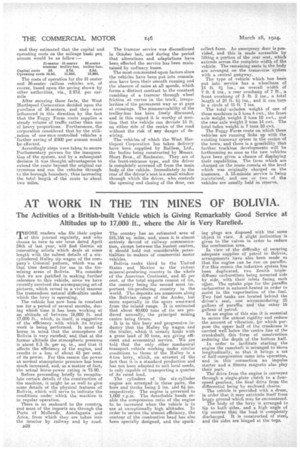AT WORK IN THE TIN MINES OF BOLIVIA.
Page 22

If you've noticed an error in this article please click here to report it so we can fix it.
The Activities of a British-built Vehicle which is Giving Remarkably Good Service at Altitudes up to 17,000 ft., where the Air is Very Rarefied.
THOSE readers who file their copies of this journal regularly, and who choose to turn to our issue dated April 24th of last year, will find therein ap interesting article which deals at some length with the salient details of a sixcylindered Halley tip wagon of the company's Colonial pattern, which was at that time destined for use in the tinmining areas of Bolivia. We consider that we are justified in making furthee reference to. this vehicle, since we have recently received the accompanying set of pictures, which reveal in a vivid manner the tremendous natural difficulties under which the lorry is operating. The vehicle has pow been in constant use for aperiod of several months, during which time it has been working at an altitude of between 16,000. ft. and 17,000 ft., which, in itself, is suggestive of the efficiency with which its trying work is being performed. It must be borne in mind that the atmosphere of Bolivia is very rarefied; and.that at the former altitude the atmospheric pressure is about 8.3 lb. per sq. in., and that it affects the efficiency of the engine, and results in a loss of about 43 per cent. of its power. For this reason the power at normal atmospheric pressure has been much increased, and, as a matter of fact, the actual horse-power rating is 75-90.
Before proceeding briefly to recapitulate certain details of the construction of the machine, it might be as well to give some details of the physical features of Bolivia, which will serve to indicate tho conditions under which the machine is in regular operation. There is no seaboard to the c.ountrasy and most of the imports are through the Ports of Mollenclo, Antofagasta and Arica, from which they are taken into the interior by railway and by road. B38 The country has an estimated area of 515,156 sq. miles, and, since it is almost entirely devoid of railway communication, except between the busiest centres, it should hold out considerable potentialities to makers of commercial motor vehicles.
Bolivia ranks third to the United States and Mexico as the richest mineral-producing country in the whole of the American Continent, and 85 per cent, of the total exports consist of till, the country being the second most important tin-producing country in the world. The deposits are numerous along the Bolivian range of the Andes, but snore especially in the spurs westward from the inland range. It is estimated that about 40.000 tons of tin are produced annually, the principal mining centre being Oruro.
It is in this busy and progressiveindustry that the Halley tip wagon and the trailer, which it usually hauls with a gross load of 10 tons, are giving efficient and economical service. We are -told that the only other mechanical transport vehicle working under similar conditions to those of the Halley is a 4-ton lorry, which, an account of the fact that it, is a standard production and has not been adapted to suit local needs, is only capable of transporting a quarter of its rated load.
The cylinders of the six-cylinder engine are arranged in three pairs, the bore and stroke being 5 ins. and 61 ins. respectively. The engine is governed to 1,000 r.p.m. The detachableheads enable the compression ratio of the engine to be increased when the vehicle is in use at exceptionally high altitudes. In order to secure the utmost efficiency, the contour of the combustion head has also been Specially designed, and the spark ing plugs are disposed with the same —object in view. A slight inclination is given to the valves in order to reduce the combustion area.
In view of the difficulty of securing adequate supplies of petrol in Bolivia, arrangements have also been made so that the engine can be run on paraffin. For this reason the induction system has been duplicated, two Zenith triplediffuser carburetters being mounted side by side, with their' inlets facing each other. The uptake pipe for the paraffin carburetter is exhaust-heated in Order to assist in the vaporization of thefuel. Two fuel tanks are located behind the driver's seat, one accommodating 25 gallons of paraffin and the other 16 gallons of petrol. • In an engine of this size it is essential to sedum the utmost rigidity and reduce the amount of vibration, for which pur'pose the upper half of the crankcase is carried well below the centre line of the crankshaft, this form of construction -reducing the depth of the bottom half. In order to facilitate starting the engine the camshaft is arranged to Move longitudinally, so that it brings a set of half-compeesaion cams into operation, and in this connection an impulse starter and a Simms magneto also play • their part. ,
The drive from the engine is conveyed through a single-plate clutch to a fourspeed gearbox, the final drive from the differential being by encleSed chains.
The vehicle is provided with a drum, in order that it may extricate itself from boggy ground which may be encountered.
The body of the lorry is arranged to tip to both Sides, and a high 'angle of tip ensures that the load is -completely discharged. It is constructed of steel, and the sides are hinged at the togs.




























